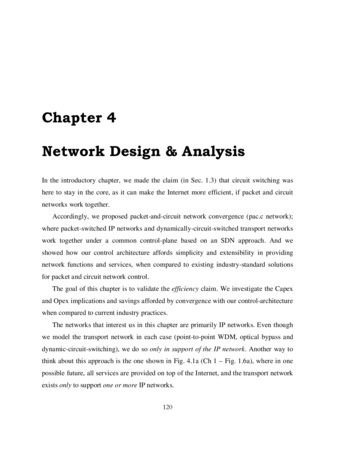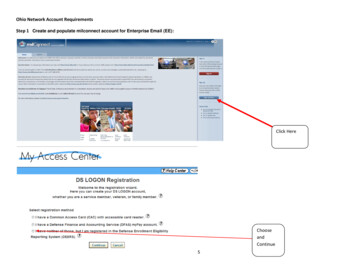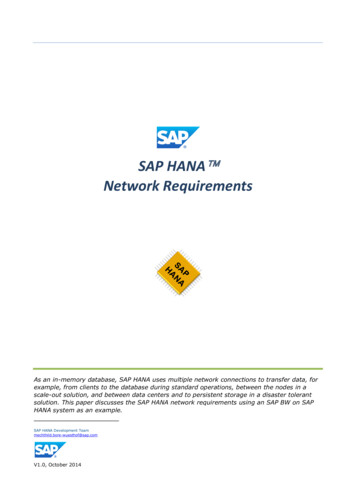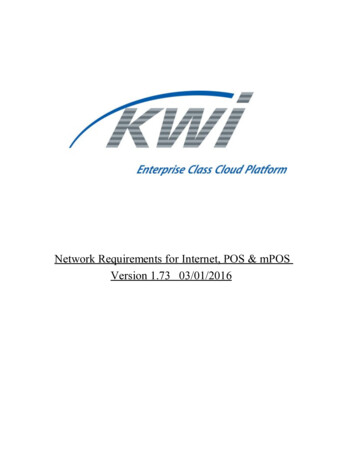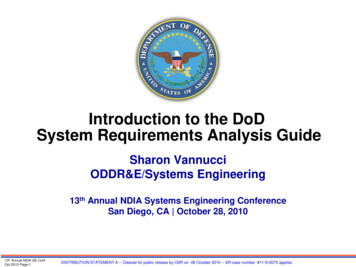
Transcription
Chapter 1Network Design Requirements:Analysis and Design PrinciplesDesigning large-scale networks to meet today’s dynamic business and IT needs andtrends is a complex assignment, whether it is an enterprise or service provider type ofnetwork. This is especially true when the network was designed for technologies andrequirements relevant years ago and the business decides to adopt new IT technologiesto facilitate the achievement of its goals but the business’s existing network was notdesigned to address these new technologies’ requirements. Therefore, to achieve thedesired goal of a given design, the network designer must adopt an approach that tacklesthe design in a structured manner.There are two common approaches to analyze and design networks: The top-down approach: The top-down design approach simplifies the design process by splitting the design tasks to make it more focused on the design scope andperformed in a more controlled manner, which can ultimately help network designers to view network design solutions from a business-driven approach. The bottom-up approach: In contrast, the bottom-up approach focuses on selecting network technologies and design models first. This can impose a high potentialfor design failures, because the network will not meet the business or applications’requirements.To achieve a successful strategic design, there must be additional emphasis on a businessdriven approach. This implies a primary focus on business goals and technical objectives,in addition to existing and future services and applications. In fact, in today’s networks,business requirements are driving IT and network initiatives as shown in Figure 1-1 [6].For instance, although compliance (as presented in Figure 1-1) might seem to be a designconstraint rather than a driver, many organizations today aim to comply with somestandards with regard to their IT infrastructure and services to gain some business advantages, such as compliance with ISO/IEC 27001 Information Security Management,1 will1. tandards/iso27001.htmCCDE study Guide Ch01 p003-030v3.0.3.indd 315/09/15 3:25 pm
4Chapter 1: Network Design Requirements: Analysis and Design PrinciplesBusiness DriversIT/Network InitiativesCost EfficienciesNetwork Consolidation andVirtualizationElasticityAdaptable and Responsive DesignComplianceCompliance with Industry Standardssuch as ISOBusiness ContinuityNetwork and Services ResiliencyAccess ControlEnd-End Network ConfidentialityFigure 1-1Business Drivers Versus IT Initiativeshelp businesses like financial services organizations to demonstrate their credibility andtrust. This ultimately will help these organizations to gain more competitive advantages,optimize their operational uptime, and reduce operational expenses (fewer number ofincidents as a result of the reduced number of information security breaches).Throughout this book and for the purpose of the CCDE exam, the top-down approachis considered as the design approach that can employ the following top-down logiccombined with the prepare, plan, design, implement, operate and optimize (PPDIOO)lifecycle: Analyze the goals, plans, and requirements of the business. Define application requirements from the upper layers of the Open SystemsInterconnection (OSI) reference model that can help to identify the characteristicsof an application. Specify the design of the infrastructure along with the functional requirements of itscomponents, for the network to become a business enabler. Monitor and gather additional information that may help to optimize and influencethe logical or physical design to adapt with any new application or requirements.Design ScopeIt is important in any design project that network designers carefully analyze and evaluate the scope of the design before starting to gather information and plan networkdesign. Therefore, it is critical to determine whether the design task is for a green field(new) network or for a current production network (if the network already exists, theCCDE study Guide Ch01 p003-030v3.0.3.indd 415/09/15 3:25 pm
Business Requirements5design tasks can vary such as optimization, expansion, integration with other externalnetworks, and so on). It is also vital to determine whether the design spans a singlenetwork module or multiple modules. In other words, the predetermination of thedesign scope can influence the type of information required to be gathered, in additionto the time to produce the design. Table 1-1 shows an example of how identifying thedesign scope can help network designers determine the areas and functions a certaindesign must emphasize and address. As a result, the scope of the information to beobtained will more be focused on these areas.Table 1-1Design ScopeDesign ScopeDetailed Design Scope ExampleEnterprise campusnetwork and remote sitesRollout of IP telephony across the enterprise, which mayrequire a redesign of virtual LANs (VLANs), quality of service(QoS), and so on across the LAN, WAN, data center (DC),and remote-access edgeCampus onlyAdd multi-tenancy concept to the campus, which requires designof VLANs, IPs, and path isolation across the campus LAN onlyOptimize enterprise edgeavailabilityAdd redundant link for remote access, which might requireredesign of the WAN module and remote site designs andconfigurations such as overlay tunnelsNote Identifying the design scope in the CCDE exam is very important. For example,the candidate might have a large network to deal with, whereas the actual design focusis only on adding and integrating a new data center. Therefore, the candidate needsto focus on that part only. However, the design still needs to consider the network asa whole, a “holistic approach,” when you add, remove, or change anything across thenetwork (as discussed in more detail later in this chapter).Business RequirementsThis section covers the primary aspects that pertain to the business drivers, needs, anddirections that (individually or collectively) can influence design decisions either directlyor indirectly. The best place to start understanding the business’s needs and requirements is by looking at the big picture of a company or business and understanding itsgoals, vision, and future directions. This can significantly help to steer the design to bemore business driven. However, there can be various business drivers and requirementsbased on the business type and many other variables. As outlined in Figure 1-2, with atop-down design approach, it is almost always the requirements and drivers at higher layers (such as business and application requirements) that drive and set the requirementsand directions for the lower layers. Therefore, network designers aiming to achieve abusiness-driven design must consider this when planning and producing a new networkCCDE study Guide Ch01 p003-030v3.0.3.indd 515/09/15 3:25 pm
6Chapter 1: Network Design Requirements: Analysis and Design Principlesdesign or when evaluating and optimizing an existing one. The following sections discusssome of the business requirements and drivers at the higher layers and how each caninfluence design decisions at the lower layers.Business GoalsTop-DownBusinessContinuityStrategic BusinessTrendsMerger, Accusation,DivestInnovationMore.Business ApplicationsTechnical and Functional RequirementsNetwork Infrastructure SolutionsRouting, Switching, Mobility, SecurityFigure 1-2Higher layers set the requirements of the lower layersBusiness Drivers and RequirementsBusiness-Driven Technology SolutionsBusiness ContinuityBusiness continuity (BC) refers to the ability to continue business activities (businessas usual) following an outage, which might result from a system outage or a naturaldisaster like a fire that damages a data center. Therefore, businesses need a mechanismor approach to build and improve the level of resiliency to react and recover fromunplanned outages.The level of resiliency is not necessarily required to be the same across the entirenetwork, however, because the drivers of BC for the different parts of the network canvary based on different levels of impact on the business. These business drivers mayinclude compliance with regulations or the level of criticality to the business in case ofany system or site connectivity outage. For instance, if a retail business has an outage inone of its remote stores, this is of less concern than an outage to the primary data center,from a business point of view. If the primary data center were to go offline for a certainperiod of time, this would affect all the other stores (higher risk) and could cost thebusiness a larger loss in terms of money (tangible) and reputation (intangible). Therefore,the resiliency of the data center network is of greater consideration for this retailer thanthe resiliency of remote sites [17].CCDE study Guide Ch01 p003-030v3.0.3.indd 615/09/15 3:25 pm
Business Requirements7Similarly, the location of the outage sometimes influences the level of criticality anddesign consideration. Using the same example, an outage at one of the small stores ina remote area might not be as critical as an outage in one of the large stores in a largecity [11]. In other words, BC considerations based on risk assessment and its impact onthe business can be considered one of the primary drivers for many businesses to adaptnetwork technologies and design principles to meet their desired goals [5].Elasticity to Support the Strategic Business TrendsElasticity refers to the level of flexibility a certain design can provide in response tobusiness changes. A change here refers to the direction the business is heading, which cantake different forms. For example, this change may be a typical organic business growth,a decline in business, a merger, or an acquisition. For instance, if an enterprise campushas three buildings and is interconnected directly, as illustrated in Figure 1-3, any organicgrowth in this network that requires the addition of a new building to this network willintroduce a lot of complexity in terms cabling, control plane, and manageability. Thesecomplexities result from the inflexible design, which makes the design incapable ofresponding to the business’s natural growth demand.Building BBuilding CBuilding AFigure 1-3Inflexible DesignTo enhance the level of flexibility of this design, you can add a core module tooptimize the overall design modularity to support business expansion requirements.As a result, adding or removing any module or building to this network will not affectother modules, and does not even require any change to the other modules, as illustrated in Figure 1-4. In other words, the design must be flexible enough to support thebusiness requirements and strategic goals. If network designers understand businesstrends and directions in this area, such understanding may influence, to a large extent,deign choices.CCDE study Guide Ch01 p003-030v3.0.3.indd 715/09/15 3:25 pm
8Chapter 1: Network Design Requirements: Analysis and Design PrinciplesBuilding BBuilding CBuilding ACore ModuleFigure 1-4Flexible DesignSimilarly, a flexible network design must support the capability to integrate with othernetworks (for examples, when mergers and acquisitions occur). With mergers and acquisitions, however, the network can typically grow significantly in size within a shortperiod of time, and the biggest challenge, in both scenarios (mergers and acquisitions),is that network designers have to deal with different design principles, the possibility ofoverlapping IP address space, different control plane protocols, different approaches,and so on.IT as a “Business Innovation” EnablerIn today’s market, many businesses understand how IT technologies enhance their services and provide innovation to their customers. Therefore, when a certain technologycan serve as a business enabler that can help the organization to compete in the marketor increase its customers’ satisfaction, the adoption of that technology will be supportedby the business [17].For example, nowadays, cloud-based data centers are opening new opportunities forhosting service providers to generate more revenue for the business. To offer goodcloud-based services, there must be a reliable, flexible, and high-performance data centerinfrastructure to deliver this service. Consequently, this engenders the initiative and willdrive the business to build a high-performance, next-generation data center network.CCDE study Guide Ch01 p003-030v3.0.3.indd 815/09/15 3:25 pm
Functional Requirements9This network, by acting as a basis for cloud services, will be the enabler of the business’srevenue-generation solution.The Nature of the BusinessClassifying the industry in which the business belongs or identifying the business’sorigins can aid in the understanding of some indirect requirements, even if these arenot mentioned explicitly. For example, information security is almost always a mustfor a banking business whenever traffic crosses any external link. So by default, whenplanning a design for a business based in the banking industry, the design must support or offer security capabilities to gain acceptance from the business. In addition,industry-specific standards apply to IT infrastructure and services need to be considered.(For instance, healthcare organizations may consider complying with the IEC-80001-1standard.2)Business PrioritiesEach business has a set of priorities that are typically based on strategies adopted for theachievement of goals. These business priorities can influence the planning and design ofIT network infrastructure. Therefore, network designers must be aware of these businesspriorities to align them with the design priorities. This ensures the success of the networkthey are designing by delivering business value. For example, company X’s highest priority is to provide a more collaborative and interactive business communication, followedby the provision of mobile
6 Chapter 1: Network Design Requirements: Analysis and Design Principles design or when evaluating and optimizing an existing one. The following sections discuss some of the business requirements and drivers at the higher layers and how each can influence design decisions at the lower layers. Top-Down Business Drivers and RequirementsFile Size: 209KBPage Count: 27


